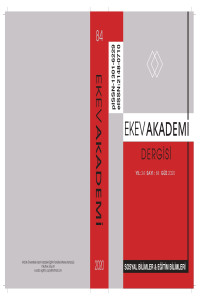Öz
Bu araştırmada, ölçek geliştirme ve uyarlama çalışmalarında sıklıkla kullanılan doğrulayıcı faktör analizinde kodeğişkenlerin model veri uyumu üzerindeki etkisinin incelenmesi amaçlanmıştır. Doğrulayıcı faktör analizinde kodeğişkenin etkisinin araştırılması yönüyle bu araştırmanın türü temel araştırma niteliği taşımaktadır. Araştırma, PISA 2018 Türkiye uygulamasına katılan öğrencilerden oluşmaktadır. Veriler, PISA 2018 uygulamasının öğrenci anketindeki çeşitli ölçekler kullanılarak elde edilmiştir. Verilerin analizinde McDonald ω, Cronbach α, doğrulayıcı faktör analizi ve çoklu gösterge çoklu neden modelleme kullanılmıştır. Araştırma kapsamında elde edilen bulgulara göre, doğrulayıcı faktör analizi sonucunda elde edilen model-veri uyumunun çoklu gösterge çoklu neden modelleme sonucunda elde edilen model-veri uyumundan daha kötü olduğu bulunmuştur. Buna göre ölçek geliştirme ve uyarlama çalışmalarında sadece ölçek maddelerine verilen yanıtlar değil aynı zamanda bireye ilişkin değişkenlerin de (kodeğişkenler) dikkate alınması gerektiği düşünülmektedir. Kodeğişkenlerin analizlere dâhil edilmesi sonucu yapının eksik temsil edilme ihtimaliyeti azalır ve böylelikle ölçümlerin geçerliğine katkı sağlanmış olacaktır.
Anahtar Kelimeler
MIMIC model doğrulayıcı faktör analizi kodeğişken geçerlik güvenirlik.
Kaynakça
- Anderson, J. C. & Gerbing, D. W. (1984). The effect of sampling error on convergence, improper solutions and goodness-of-fit indices for maximum likelihood confirmatory factor analysis. Psychometrika, 49(2), 155-173. https://doi. org/10.1007/BF02294170
- Bollen, K., & Lennox, R. (1991). Conventional wisdom on measurement: A structural equation perspective. Psychological Bulletin, 110(2), 305. https://doi. org/10.1037/0033-2909.110.2.305
- Brailean, A., Guerra, M., Chua, K. C., Prince, M., & Prina, M. A. (2015). A multiple indicators multiple causes model of late-life depression in Latin American countries. Journal of affective disorders, 184, 129-136. https://doi.org/10.1016/ j.jad.2015.05.053
- Brown, T. A. (2015). Confirmatory factor analysis for applied research. New York: Guilford Publications.
- Cantero, M.J.,Alfonso-Benlliure,V.,& Melero,R.(2016).Creativity inmiddle childhood: Influence of perceived maternal sensitivity, self-esteem, and shyness. Creativity Research Journal, 28(1), 105-113. http://dx.doi.org/10.1080/10400419.2016.11 25246
- Crowley, S. L., & Fan, X. (1997). Structural equation modeling: Basic concepts and applications in personality assessment research. Journal of personality assessment, 68(3), 508-531. https://doi.org/10.1207/s15327752jpa6803_4
- Erkorkmaz, Ü., Etikan, İ., Demir, O., Özdamar, K., & Sanisoğlu, S. Y. (2013). Doğrulayıcı faktör analizi ve uyum indeksleri. Türkiye Klinikleri Journal of Medical Sciences, 33(1), 210-223. https://doi.org/10.5336/medsci.2011-26747
- Fan, Y. (2014). Moderated mediation with MIMIC models: SEM analysis of personal resources, perceived age-related loss, and aging satisfaction. Doctoral Dissertation, Fordham University.
- Grayson, D. A., Mackinnon, A., Jorm, A. F., Creasey, H., & Broe, G. A. (2000). Item bias in the center for epidemiological studies depression scale: Effects of physical disorders and disability in an elderly community sample. Journal of Gerontology: Psychological Sciences: 55(5), 273-282. https://doi.org/10.1093/ geronb/55.5.P273
- Guan, M. (2017). Measuring the effects of socioeconomic factors on mental health among migrants in urban China: a multiple indicators multiple causes model. International journal of mental health systems, 11, 1-11. https://doi.org/10.1186/ s13033-016-0118-y
- Hancock, G. R., Lawrence, F. R., & Nevitt, J. (2000). Type I error and power of latent mean methods and MANOVA in factorially invariant and noninvariant latent variable systems. Structural Equation Modeling: A Multidisciplinary Journal, 7(4), 534-556. https://doi.org/10.1207/S15328007SEM0704_2
- Jiao, C., Yan, D., & Wang, T. (2016). Weight perception, body size, self-esteem and social anxiety in obese adolescents: a Multiple Indicators Multiple Causes (MIMIC) model. International Journal of Psychology and Behavioral Sciences, 6(1), 1-6. http://dx.doi.org/10.5923/j.ijpbs.20160601.01
- Kaptan, S. (1998). Bilimsel araştırma ve istatistik teknikleri. Ankara: Tek ışık Web Ofset Tesisleri
- Kim, E. S. (2011). Testing measurement ınvariance using MIMIC: Likelihood ratio test and modification indices with a critical value adjustment. Doctoral Dissertation, Texas A&M University, College Station. https://doi.org/10.1177/00131644114 27395
- Kline, R. B. (2011). Principles and practice of structural equation modeling. New York, NY: Guilford Press.
- Lubke, G. H., & Muthén, B. (2005). Investigating population heterogeneity with factor mixture models. Psychological methods, 10(1), 21-39. https://doi. org/10.1037/1082-989X.10.1.21
- Messick, S. (1995). Validity of psychological assessment. American Psychologist, 50(9), 741-749. https://doi.org/10.1037/0003-066X.50.9.741
- Muthen, B. O. (1988). Some uses of structural equation modeling in validity studies: Extending IRT to external variables. In H. Wainer, & H. I. Braun (Eds.), Test validity (pp. 213-238). Hillsdale, NJ: Lawrence Erlbaum Associates, Inc.
- Muthen, B. O. (1989). Latent variable modeling in heterogeneous populations. Psychometrika, 54(4), 557–585. https://doi.org/10.1007/BF02296397
- SchumacherR.E., LomaxR.G.,(2004). A beginner‘s guide to SEM. New Jersey: Lawrenge Erlbaum Associotes, Publishers.
- Wheaton, B. (1987). Assessment of fit in overidentified models with latent variables. Sociological Methods ve Research, 16(1), 118-154. https://doi.org/10.1177/004 9124187016001005
- Woods, C. M. (2009). Evaluation of MIMIC-model methods for DIF testing with comparison to two-group analysis. Multivariate Behavioral Research, 44(1), 1- 27. https://doi.org/10.1080/00273170802620121
- Xie, Y. (2013). Population heterogeneity and causal inference. Proceedings of the National Academy of Sciences, 110(16), 6262-6268. https://doi.org/10.1073/ pnas.1303102110
Ayrıntılar
| Birincil Dil | Türkçe |
|---|---|
| Bölüm | Makaleler |
| Yazarlar | |
| Yayımlanma Tarihi | 27 Aralık 2020 |
| Yayımlandığı Sayı | Yıl 2020 Sayı: 84 |


